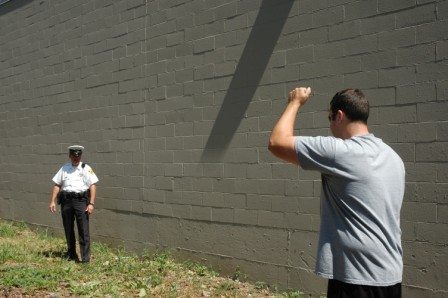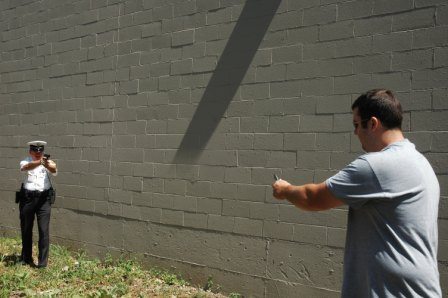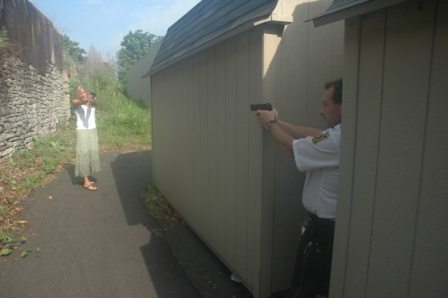NYPD Officers Shoot and Kill Knife-Wielding Man: Justified?
Police in New York City shot and killed a man who lunged at them with a large kitchen knife. In fact, several bystanders caught the deadly encounter on cell phone video. The scenario unfolded when officers approached 51-year-old Darrius Kennedy after spotting him smoking marijuana at 44th St5reet and 7th Ave. As the officers attempted to restrain him, Kennedy began to struggle, breaking free of the officers’ grasp. He then produced a large Ikea knife and started backing away, waving the knife at them. He also took a few swipes at pedestrians, possibly cutting one, during his backwards walk down the middle of the street.
Several police officers, with weapons drawn, joined in on the slow-motion walking pursuit of Kennedy. They repeatedly yelled for him to drop the knife, and they used pepperspray at least six times, hoping he’d be forced to put down the deadly weapon. Unfortunately, neither tactic worked. So, two patrol cars attempted to block Kennedy’s path, but he managed to get by the first car. However, when the officers in the second car got out, well, that’s when Kennedy made his move, lunging at the officers, aiming the knife in their direction. The two NYPD officers then discharged their weapons. One officer fired 9 times. The other fired 3 rounds.
Immediately after the shots were fired, bystanders began yelling that the shooting was unjustified. One man even went so far as to say the suspect had been shot in the back, even though he was not in a position to see the event. Comments on many websites, Twitter, and Facebook demand that the officers involved be charged with murder. A cousin of Kennedy’s said she didn’t understand why the officers didn’t fire a warning shot, or simply shoot him in the leg or arm. His aunt stated that she believed there were other, better ways to handle the situation with her nephew. She also said they didn’t have to shoot him so many times.
Here are five of the hundreds upon hundreds of anti-police comments posted online regarding this incident:
– Pigs want trigger time. They shoot to kill.
– should have shot him in the leg or arm arent they trained to shoot at specific targets murderers
– The victim was holding a knife with a 6 inch blade. That’s seems like a huge target. With all the police surrounding him, not one of them could shoot it out of his hand? Not even fire off a few warning shots into the air? These questions need to be answered.
– Police could have did things. The kind of provoked his reaction buy cornering him. Even though they could not tell if he was EDP or not they should have saw some of the signs and not backed him into a corner or make him feel any more threatened then he already did. That was excessive force! As soon as the pepper spray did not work they should have known something else was wrong with him.
– You’re just like the rest of the 10 cowdly cops who shot the man because that’s all their train to do. NYPD is a bunch of butchers as usual. Just shoot the suspect Ray Kelly has your back.
So what are the rules when officers encounter knife-wielding suspects? Was this a justified shooting by the NYPD officers? Of course it was, and here’s why.

Police officers are forced to make many split second decisions during the course of their careers, and one of those decisions is when to use force. If they choose to use force they’re then faced with deciding which level of force should be employed. Should a Taser be used when a combative suspect is holding a knife? Should the officer go for her firearm if the suspect is swinging a baseball bat at her head? Is an officer ever justified to shoot an unarmed suspect? Are there situations when officers must retreat? All of these decisions are made within one-half to three-quarters of a second. That’s about how long it takes the average human to react to a given situation.
Let’s first examine the scenario pictured above. Here, an officer stands facing a knife-wielding suspect who clearly presents a danger. The bad guy is holding an edged weapon (a knife) in the classic “ice pick” position. Years ago officers were taught that a suspect could be shot, and justifiably so, if he were wielding a knife in a threatening manner while positioned within a distance of twenty-one feet from the officer (the 21 foot rule). The reasoning was that the suspect was without a doubt an immediate, deadly threat. Officers were taught that they’d not likely survive this scenario without using deadly force. In fact, it’s doubtful that an officer could draw his weapon and squeeze off a round, without aiming, if a suspect began his charge from a distance of twenty-one feet or less. Suppose the officer did properly assess the threat and did manage to draw his weapon and fire. How long would it take to think about and perform those two basic tasks?
The fastest officer tested was able to draw his weapon from a security holster in a little under 1.5 seconds. The slowest was a about 2.25 seconds. Sounds pretty fast, huh? Maybe not.
The average suspect can cover the distance (21 feet as seen above) to the officer in as little as 1.5 seconds, nearly a full second quicker than the slowest officer is able to defend himself.
Today, officers must rethink the twenty-one foot rule a bit. Sure, the thug is potentially a deadly threat, but not an actual deadly threat until he makes some sort of hostile movement toward the officer. Of course, the officer should have his firearm in a ready position as soon as he perceives the threat. And this is a situation where the officer should always choose his firearm over a non-lethal weapon, such as a Taser or pepperspray. Remember the the old saying, “Never bring a knife to a gunfight?” Now there’s a new addition to that rule. It’s, “Never bring a Taser to a knife fight.”
The key to knowing when it’s time to shoot is simple. If the officer feels that his life, or the life of an innocent person, is at risk, then the shoot is justified. However, the officer must be prepared to articulate his reasons for pulling the trigger. Was the suspect making stabbing motions while advancing? Was he charging at, or lunging toward the officer?
There are reasons that may not justify the shoot, such as the suspect being so intoxicated that he couldn’t possibly have followed through with the threat. In short, the threat must be real, or at least perceived as being real in the eyes of the officer. However, if the threat is real and incoming, then there’s no doubt…deadly force is justified.
And, the officer must be able to recognize when a threat is over. If the suspect drops his weapon the justification for deadly force ends immediately.
When a suspect points a firearm at an officer, deadly force is immediately justified.
In situations like the one pictured above, it’s not uncommon for officers to hesitate briefly before using force to stop the threat. Why? Interestingly, officers often perceive women and children as being less of a threat than a male suspect. That’s why FATS and other simulated firearms training uses both women and children in the shoot/don’t shoot scenarios. The woman in the picture above is very much a deadly threat, therefore, the officer is justified in using deadly force.
Again, based on what we see in the above video (and others) of the recent NYPD, the use of deadly force was justified.
By the way, police officers are trained to shoot center mass. They are NOT trained to shoot arms or legs, because those are generally hard-to-hit moving targets, and a miss could result in stray bullets hitting innocent bystanders. Not to mention a miss would provide the suspect even more time to complete his attack on the officer. And, police officers NEVER fire warning shots. After all, what goes up must come down, and where it lands nobody knows (bullets fired into the air could easily strike innocent people, including young children and babies). Also, firing a warning shot would leave the officer with one less round in her weapon.






In Patriot Games, Tom Clancy brings up this exact point. When Jack Ryan is being grilled on the stand by the defense attorney about Ryan’s shooting of someone who was attacking the royal family, the attorney suggests, “you could have shot the gun out of his hand”.
Ryan’s response was along the lines of the end of Lee’s article–arms and legs were easy to miss targets.
While I have no doubt that there are some unjustified police shootings, I also believe that police officers are put under unecessary scrutiny these days. And I think there are some elements of the media that DO egg on anti-police sentiment.
So how do you really feel, Dave?
Let’s see, the guy was smoking an illegal substance in public, resisted arrest (was that what the officers were doing, trying to arrest him?), threatened numerous police officers and civilians with a knife, refused to obey an order to drop the knife, and attempted to flee.
And people are upset the officers shot him?
I think the officers showed great professionalism in giving him every chance to co-operate and great restraint in not dropping him at the first swing of his knife.
As for those illiterate yahoos spouting their ignorant tripe about the trigger happy police officers, they don’t even merit consideration.
You’re right, Nike. Officers always shoot center mass. Never for a hand, a knife, a gun, the kneecap, or anything else. And, no, retreat was not an option in this case.
There have been numerous NYPD shootings where the officers discharged their weapons several times. In this case, they don’t shoot once and knock the weapon out of the assailants hand. I’ve been listening to local reports and all have said NYPD officers shot at body mass. This was an area with heavy foot traffic. Had the officers aimed for the assailant’s hand or leg and missed, they could’ve hit an innocent pedestrian.
Now, we could wish they’d had shields and could’ve surrounded the assailant and forced him to relinquish the weapon. But they didn’t have shields.
I do not believe the police could chose to retreat. The assailant was in a mid-town area with heavy pedestrian traffice. In a matter of minutes the assailant would’ve been in Times Square, one of the most crowded areas, if not the most crowded area in the city with foot traffic.
It’s nice to think it throught for them and figure out later how they could’ve done it better..
Good article Lee. I’d rather they shoot the guy than end up dead or in a hostage situation.
Lee, it on on the news that this guy had a 10 page rap sheet, had been in jail, shot at cop previously, and a supervisor with a stun gun had been sent for and was on his way to the scene. I think the LEOs tried all they could do under the circumstances.
Lee, as always, you cut to the heart of the matter in an articulate and unbiased manner. We rely on the police to protect us, yet there are those who are quick to object when they do their jobs.
Tim – When deadly force is needed, officers fire until the threat is terminated, whatever that means for each scenario.
Clearly, anyone who thinks shooting a weapon out of someone’s hand, shooting a limb instead of center mass, or firing a “warning” shot are reasonable alternatives is dangerously ignorant. And just as clearly, based on this description of the events, it was a justified use of deadly force.
But I wonder if the number of shots is fueling some of the controversy? To those of us with no experience with guns, we naturally question why one officer fired so many more times than the other. We question why it took 12 shots rather than 10 or six or three or one. Do review boards ask those kinds of questions too?
This is another fascinating post with great information. Thanks.
It’s a given these days that when a cop shoots someone who’s not wielding a gun is using excessive force.
Where I live, a few months ago, a drunken woman turned violent. The cops caught up to her and her wielding a chair. After repeatedly telling her to drop it and get down and she charged them, she was tasered. Not shot, tasered, and there was an uproar over excessive use of force.
The only way you could ever stop this is for everyone, starting with reporters and community leaders, to take the same FATS training we get at Lee’s Writers Police Academy. Then they’d see for themselves the kind of split second decision making a cop has to do when faced with an armed person. Even that might not help. Some folks just love hating the police — until they need them of course, then they can’t come fast enough.
Next thing you know, those idiots posting on social media will be the ones making up the civilian review board.
Too much Hollywood, not enough real life.
Looking at the civilian “responses” printed at the end of the original article, I had to laugh at the opinion of the fine, upstanding citizen whose spelling and grammar showed just how informed and objective he was. Good grief. Sometimes I think the media just tries to egg on anti-police sentiments. Just wait until that fool finds himself in a theater with a lunatic firing a semi-automatic.
It’s possible to use something like that, sure, Steven. And that would have been a time to try it, and officers most likely would have, if possible (remember, they tried pepperspray six times). But as you say, it wasn’t available, nor would it have been appropriate to wait for one’s availability. Besides, a suspect waving a knife around is a clear and imminent danger.
Yes, officers are trained to use all weapons that are available to them. But, in this instance the scenario unfolded within seconds, leaving the officers no time to do anything but what they did.
In fact, based on what I’ve seen and read, I believe they may have waited longer than they actually should have before terminating the threat to the citizens in the area. The suspect could have grabbed any number of people from the sidewalks and taken them hostage, or worse.
Sounds like a good shoot to me. In fact, I’m not sure even I can come up with a grey area in this one. Clearly he’s armed, clearly he presents a danger to others, and once you pull the trigger, I’m hoping you’re hitting the guy in center mass. It’s the dark alley and the perp pulls a wallet and the officer involved is asked why he was interested in the perp in the 1st place and they say, “Well, I was going to stop him and ask a few questions, but he ignored me and kept walking, so I…” that I have questions.
I do wonder, however, whether shotgun beanbags might have been called for here at any point BEFORE he rushes the officer at the end. (Not that the officers had that available, but just IF they had that, would they have normally been trained to use it during that low speed chase.)
People were cut by the knife, according to one witness, and the cops still let him have a chance to drop the knife. Pretty generous and risky in my view. When he came at them, they had no choice. The use of deadly force by the police always brings out strong emotions in witnesses. It reminds them that ultimately the state has deadly force at it’s command, and people don’t like that.
I am so tired of these bystanders and others trying to second-guess a police shooting. It’s easy to be a Monday morning quarterback. When someone is threatening you with a deadly weapon (and a 6 inch knife can be a very deadly weapon) there are only milliseconds to make a decision. The police don’t have the luxury of sitting back and watching videos of the shooting and listening to the (probably extremely prejudiced) views of bystanders. They have to act in less than a heartbeat.
Of course, I subscribe to the belief that if the perpetrator weren’t threatening the police with a weapon, there wouldn’t be a shooting at all.
At the beginning, i believed that you’d obviously see this from a cop’s pov and support him in his act. Ahen you convinced me why you’re unbiased. Great post.
cheers.